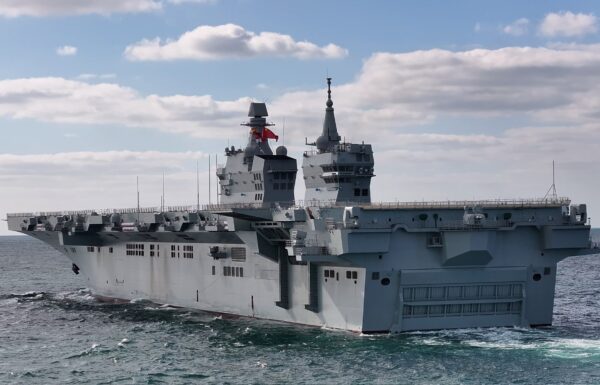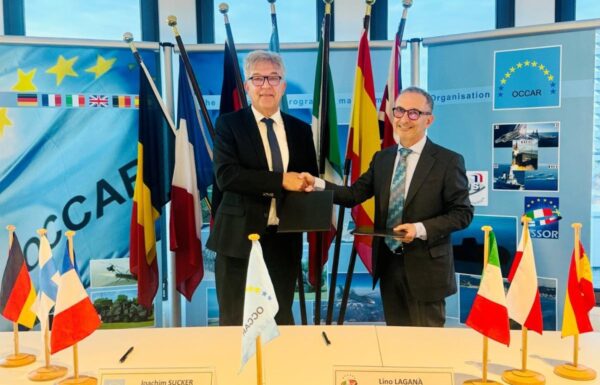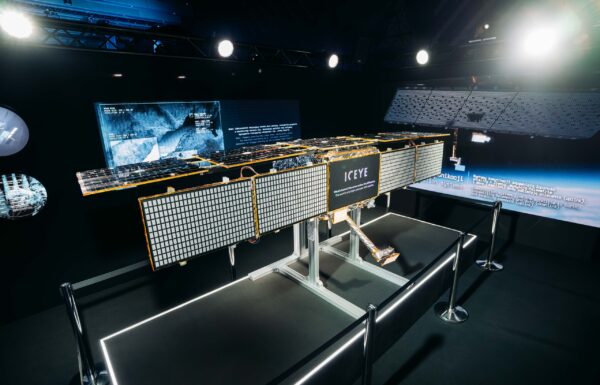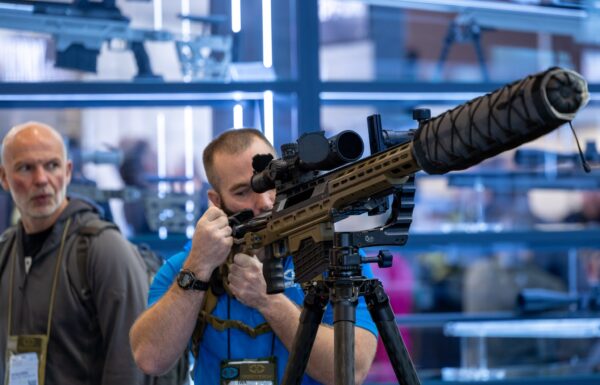On Monday, September 22, 2025, with the participation of King Charles III and UK Defence Secretary John Healey, a double ceremony was held at the BAE Systems shipyard in Barrow-in-Furness, Cumbria: the commissioning of the Royal Navy’s multirole submarine HMS Agamemnon (A124), the sixth of the Astute class, and the steel-cutting for HMS King George VI, the fourth of the Dreadnought class strategic submarines.
Agamemnon
The commissioning ceremony of the penultimate Astute-class nuclear-powered submarine was attended by around 500 guests, including the First Sea Lord and Chief of the Naval Staff, Royal Marines General Sir Gwyn Jenkins, and BAE Systems CEO Charles Woodburn.
In a rare departure from naval tradition, King Charles III read the order commissioning the submarine into service (a role usually carried out by the First Sea Lord – editor’s note). The vessel was blessed by Royal Navy Chaplain Reverend Dr. Mark Davidson and formally taken over by the submarine’s commanding officer, Commander David Bing Crosby.
Thus, the submarine joins its sister vessels HMS Astute (S119), Ambush (S120), Artful (S121), Audacious (S122), and Anson (S123), which entered service respectively on August 27, 2010, March 1, 2013, March 18, 2016, April 3, 2020, and August 31, 2022, all stationed at HMNB Clyde. They will later be joined by a seventh unit, still under construction, Achilles (S125), previously known as Agincourt, which is expected to be commissioned by the end of 2026.
HMS Agamemnon (A124) was ordered on March 25, 2010, along with Anson, under a multi-year framework contract. Design work began the same year, and on September 15, 2011, the vessel’s future name was announced, honoring the mythical king of Argolis in Greece. The keel was laid on July 18, 2013, at Devonshire Dock Hall. On April 17, 2017, a contract for the vessel’s completion was signed, with the final construction cost amounting to 1.533 billion GBP. The first powering-up of onboard systems took place on October 1, 2020.
The vessel was christened on April 23, 2024, and launched on October 3 of the same year. Outfitting work then continued, followed by sea trials, culminating in yesterday’s handover.
Agamemnon displaces 7,800 tons submerged, measures 97 meters in length and 11.3 meters in beam. Propulsion is provided by a Rolls-Royce PWR2 Core H pressurized water reactor and a 600-kilowatt MTU diesel generator. Its armament, in addition to 533 mm BAE Systems Spearfish heavyweight ASW torpedoes (Naval Staff Target 7525), includes UGM-109 Tomahawk Block IV cruise missiles.
Interestingly, this is the sixth Royal Navy vessel to bear the name Agamemnon. The first was a third-rate 64-gun sailing ship of the line from 1781, commanded by the future Vice Admiral Horatio Nelson. It was followed by a screw-propelled second-rate 91-gun ship of the line from 1852, an Ajax-class battleship from 1879, a Horatio Nelson-class pre-dreadnought battleship from 1906, and an auxiliary minelayer from 1940 (originally built in 1929 as a refrigerated cargo ship).
King George VI
On the same day, with the participation of Defence Secretary John Healey, a technical ceremony marking the first steel-cutting for the future strategic nuclear-powered submarine HMS King George VI, a Dreadnought-class vessel, was held at the same shipyard. It will be the last, fourth submarine of this class, which will replace the Vanguard-class boats: HMS Vanguard (S28), Victorious (S29), Vigilant (S30), and Vengeance (S31).
Construction has so far included HMS Dreadnought (steel cut on October 6, 2016, with the keel laid on March 20, 2025), Valiant (steel cut in September 2019), and Warspite (steel cut on February 9, 2023). Building all four is expected to take around 20 years. The submarines will each measure 153.6 m in length, 12.8 m in beam, 12 m in height, and displace 17,200 tons. They will be the largest submarines in the United Kingdom’s history.
Propulsion will be provided by a Rolls-Royce PWR3 pressurized-water reactor, and the crew will number 120 officers and ratings. Armament will comprise 12 modernized UGM-133 Trident II D5LE submarine-launched ballistic missiles (SLBMs) and four 533 mm tubes for Spearfish Mod 1 heavyweight torpedoes.
The program, codenamed Successor, expected to be the most expensive defense project in UK history (38.85 billion GBP in 2023 prices), was launched in 2007. Formal preparations to begin construction of the first boat started in mid-October 2015.
The work was preceded by the announcement of preparations for the construction of the Vanguard-class successor submarines under Delivery Phase 1. By the end of 2017, 170 million GBP had been allocated for this purpose, followed by a further 130 million GBP.
In October 2018, Cammell Laird was awarded a contract to produce 29 non-pressure hull sections in Birkenhead. In July 2023, Thales Glasgow received a £193 million contract to supply optronic masts, while General Dynamics Mission Systems will deliver the fire control system. Babcock International will manufacture the missile tube assemblies in Rosyth and Bristol. Northrop Grumman will supply the missile launch subsystem equipment.
In January 2025, Rolls-Royce was awarded a 9 billion GBP contract covering research, design, production, and support for all nuclear reactors on Royal Navy submarines, including the future Dreadnought-class.
According to Admiralty plans, the first submarine is expected to enter service in the early 2030s (the original target date was 2028). Indicative commissioning dates for the subsequent boats have not been made public. Deliveries will be managed by the newly established special-purpose company Dreadnought Alliance, comprising representatives of the Ministry of Defence, BAE Systems, and Rolls-Royce.
In the future, the Dreadnought-class submarines, along with the successors to the current Astute-class, will be complemented by new-generation British-Australian submarines to be developed under the SSN-AUKUS programme, with displacements exceeding 10,000 tons. As reported on June 1 of this year, up to 12 multirole submarines are planned for procurement by His Majesty’s Government.
At the same time, plans were announced to invest 15 billion GBP in securing nuclear deterrence through the indigenous Astraea (A21/Mk7) thermonuclear warhead programme, which will replace the current 100 kT Holbrook (Mk4/A) warheads (a variant of the 90 kT U.S. W76) carried on Trident missiles that will arm the Dreadnought-class submarines. Work will be conducted at the Atomic Weapons Establishment (AWE) in Aldermaston, the ceremonial county of Berkshire.
Today, HMS Agamemnon formally entered service after a commissioning ceremony with His Majesty The King in Barrow-in-Furness. This marks an important milestone towards another Astute Class submarine joining the @RoyalNavy's fleet.
Read more 👉 https://t.co/yPZzr9qdML pic.twitter.com/brS01mYsCL
— Ministry of Defence 🇬🇧 (@DefenceHQ) September 22, 2025
⚓ Today, The King attended the Commissioning Ceremony for HMS Agamemnon, part of the Astute Class of nuclear-powered submarines. This formally marked the ship’s entry into the Royal Navy’s service. pic.twitter.com/dpPqztOJ4G
— The Royal Family (@RoyalFamily) September 22, 2025
A huge milestone today as the first steel for King George VI, the fourth Dreadnought class submarine, was cut after a ceremony led by @JohnHealey_MP.
@royalnavy Dreadnought class submarines will carry the UK's nuclear deterrent when they enter service in the 2030s. pic.twitter.com/6v4SJ1Wont— Ministry of Defence 🇬🇧 (@DefenceHQ) September 22, 2025





































